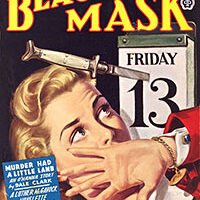I’ve been plowing through Doc Savage novels recently, prepping for one of the highlights of the annual Arizona DocCon, the trivia quiz. Among the stack were a couple of Doc novels that struck me as containing blatantly offensive material.

Both instances were derogatory references to blacks. For instance, The Pirate’s Ghost had Doc going undercover as a black man. He shuffled along, spoke in heavy dialect and often rubbed a rabbit’s foot for good luck. In Mad Mesa, Ham and Monk disguise themselves as train porters who are described as being “as black and shiny as Concord grapes.”
Such references aren’t common in Doc stories, but they are there sometimes. I’ve read nearly a dozen Doc adventures in the past month and those two were the only instances that jumped out at me. Of course, many other pulp stories include derogatory references to a wide range of ethnic groups, such as Jews, Arabs, Irish, Italians, Chinese and Japanese.
How should such offensive language or descriptions be handled in pulp reprints? In the case of the Bantam Doc paperbacks, it was included with no comment. In the future, should it be included as is, included with an explanatory note or warning label, or edited out?
Matthew Goodman at Heliograph Inc. took a unique approach in the company’s recently published book Lester Dent’s Zeppelin Tales. They created a content warning label (that’s it to the left) for the cover, much like the Entertainment Software Rating Board puts on video games.
“I knew the book would have content that would offend people,” Goodman said in an e-mail. “Heck, I added back in some offensive material that editors of the day cut out. I thought it made the book more interesting, but I wanted to make sure that people knew about it up front.”
(The stories in Zeppelin Tales are as close to Dent’s original manuscripts as they could get them, rather than based on the published versions of the stories.)
In an appendix titled “Magazine vs. Manuscript,” Goodman addresses the offensive material:
I’ve added them back because Dent clearly intended them to appear in the stories. What’s really fascinating (and telling, I think) is that they’re often used conversationally and descriptively, not as an attack on an individual’s race or religion.
In our e-mail conversation, Goodman offered an interesting twist to the common thought that what’s offensive today, wasn’t back in the 1930s.
“What I try to say in Zeppelin Tales is that much of what is offensive now was also offensive then, based on reading the manuscripts and editors’ comments,” he said. “I’ve had publishers and authors say that when modern authors write pulp it is A-OK to add in all sorts of slurs because they weren’t offensive in the 1930s. From my research, that’s just an excuse, and not even an accurate one.”
Goodman writes in Zeppelin Tales’ appendix that during the pulp era, editors frequently removed most of the offensive words from stories. And that Street and Smith Publications, in particular, had a strict policy against defamatory and inappropriate language.
As for warning labels, Goodman said, “What I did was completely because I thought it was the right thing to do. I don’t expect anyone to follow my example.”
So, with more new reprints introducing new readers to classic pulp fiction, how should offensive material be handled? I don’t have a clear answer.
– William



The stories should be left as is!! If you edit out thing that maybe someone might not like I feel you are re-inventing history. People talked that way, people felt that way so why are we trying to hide it? Sure put a warning on it if you feel you have too, but let the stories stand on there own……..So if in the future if they legilize race and hate crimes would we go back thru history and put in more race and hate crimes so it all looks politically correct in the future? Well maybe we need to digitally re-edit Casablanca and take out all the German and French insults, and while you are at it, digitally take out all those cigarettes.
Just my two cents.
I’m all for reprinting them “as is” (or was, as the case may be). It still makes me cringe a bit when I read a slur. Growing up in the Deep South during the ’60s and ’70s made me highly sensitive to derogatory comments, even when used in everyday talk “conversationally and descriptively, not as an attack on an individual’s race or religion,” as Goodman mentioned.
Probably most pulp fans would want the stories reprinted that way, too. But I wonder about reaching out to new readers. Maybe the best way would be to reprint the story “as is” and address the issue in a foreword.
(I certainly understand the fear of “political correctness.” Making everything “P.C.” would make for a very boring world.)
Oh, congratulations, Tom, on being selected to illustrate the new Spider anthology!
Thanks William….I will try to do the Spider justice….. thanks.
And I agree, on the printing of older stories…..we shouldn’t try to omit or tone down history, but if you feel the need to explain history or something to a younger audience, then they probably aren’t going to buy your products anyway. Pretty soon we will be so PC that people will think we probably shouldn’t have fought WW2. Those Nazis weren’t so bad after all, huh.